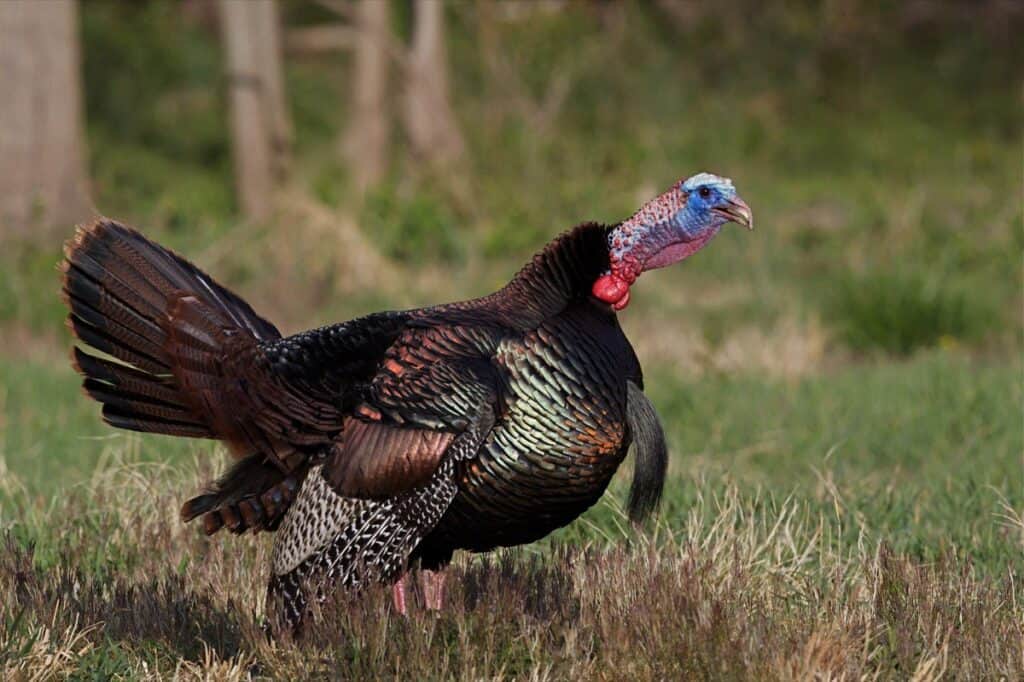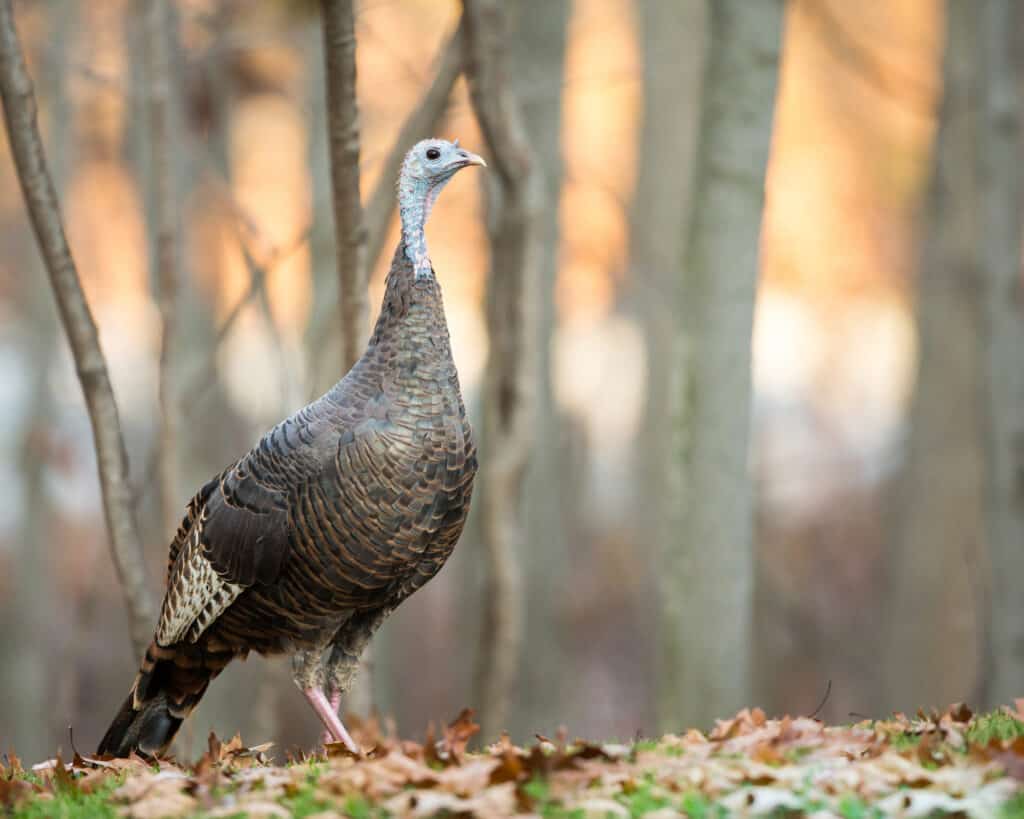All audio files in this article are courtesy of The National Wild Turkey Federation.
Wild turkeys make many different calls and sounds, and each one can mean something different. Some hunters have become turkey calling pros by using these simple sounds. To be a good turkey caller you need to understand the meaning behind the call. Being able to distinguish the different types of calls is the first step, after that, you need to be able to make the calls. Hunters use a variety of call types to give them their desired call at the right time. Many of these calls are fairly common, but adding one or two of these turkey sounds to your arsenal can put you on your way to becoming a better hunter.
Yelp
The yelp is the most basic turkey call you will hear. The yelp generally consists of shorter single notes normally strung together in a series. Both males and female turkeys make yelp calls, although it is more common to hear it from a hen. When a turkey makes a yelp call, it is to get the attention of other turkeys in the area and to basically say “here I am, lets group up”. Although, during the spring mating season, hens will use the yelp to locate and attract gobblers. This is why it is our basic call, it is one of the most simple yet effective.
Gobble
By far the most recognizable of the turkey sounds, the gobble is one of the main sounds that a male turkey will use. This sound is also the reason we call toms/male turkeys “gobblers”. Male turkeys use this call to let every turkey in the area know he is there and he wants to mate. Not only does this call serve as an attractant for hens, but it also is used to intimidate jakes and other toms. Seeing as this call is used to entice mating, we generally hear it the most during the spring season. Fall toms also gobble, but on a less frequent basis.

When turkey hunting, using the gobble should not be your first choice. Gobbling at your birds can possibly attract a large dominant male, but it will also drive away other gobblers. Another thing that the gobble attracts is hunters. If you are hunting on public land or land where you are not the only hunter, be wary of other hunters that think you are a tom.
Kee Kee Run
This call is typically made by a young turkey when it gets separated from its flock. The Kee Kee Run consists of higher pitch short notes put together in a series. They sometimes have an added yelp or two on the end. What this sound actually is, is a young bird trying to yelp back to its mother. The young turkeys’ vocals are not fully developed yet, therefore it does not sound like a yelp. As the bird gets older, it can make a Kee Kee Run sound and add a couple raspy yelps on the end. The added yelps are the “Run” part. Adult turkeys can also make this type of call, but it is not as common.
This call is usually made during the fall, but you can also use it during the spring. The Kee Kee Run may be a good call to try out if you manage to flush/separate a group of turkeys. This call will bring both males and females together that are trying to reunite after being scattered.
Purr
The purr is a turkey sound of comfort. They normally make this quiet sound when all is good and they are feeding. This is a rolling short vocalization, that continues for about a second. They then repeat the purr call until they are satisfied with the response. This sound normally comes from a female turkey as a soft friendly call, but can also come from a tom as an aggressive sound to other toms or jakes.
Putt
The putt sound is normally associated with an alarm. Turkeys make this sound when faced with danger, and you know you have been spotted if your turkeys are letting out putt calls. The sound is a short and sharp note, commonly strung together in a slow series. Although when turkeys are actively running from danger, they will let out rapid successive putts.

Hunters do not normally use the putt call, because it will alarm turkeys and possibly cause them to run off. Although if you have a gobbler with his head down, you can use this to get his attention quickly. Be ready to shoot if you choose to use this call. An alarmed turkey will bolt at the slightest bit of movement.
Cluck
The cluck is a short staccato note. Normally these sounds are made in a series of two or three. This turkey sound means that one bird wants to get the attention of another bird or for reassurance that everything is okay. For example, a hen may use this call when she is responding to the gobble of a tom or when letting him know that she has come off the roost. This call is a slower note and is oftentimes mixed in with yelps.
Mixing this call in with your normal yelps can help you attract more turkeys. If you are calling in a gobbler, using this can be the reassurance he needs to come the rest of the way to you. If you put a gobbler to bed the night before, setting up close but out of sight from his roost while using this call can be a great formula for success.
Cutt
This is a series of short and sharp notes mixed in with yelps. This turkey sound means they are excited but do not sense danger. Normally a hen will use this call when she is heated up. She is either annoyed at a slow tom or wants to intimidate other hens.
When calling a hung up tom, a cutt can be the call that gets him to you quickly; however, do not overcall the tom. If you know that the tom is preoccupied with other hens that are already cutting, then throwing out your own cutt can bring the dominant hen (and therefore her gobbler) in your direction.
Excited Yelp
The excited yelp is like the normal yelp but in more excited and rapid succession. Turkeys that make this sound are normally worked up over something, probably a hen torn up over a tom, or hens fighting for dominance.
Using this call can help you pick a fight with the dominant hen that is occupying your sought after gobbler. Yelp excitedly and repeatedly at her, cut off her vocalizations with your own. These are all the right mixes to make a hen mad and send her your way with the gobbler close behind.
Assembly Call

This call is normally used in the fall when a hen is trying to “assemble” her poults. The assembly call is a series of loud yelps that normally sounds more concerned and has longer yelps. This can be a good call to use during the fall season when a scattered flock is reuniting.
Fly-Up / Fly-Down Cackle
As the name suggests, this is the sound a turkey makes when it flies up or down from the roost. This call consists of five to ten sharp cackles that increase in pitch as the call comes to an end. The difference between a fly up and a fly down cackle is simply the time of day. These cackles are a good tool to use against stubborn gobblers. You can use a fly down cackle to get a tom down from the roost, or a fly up cackle to get a tom to roost so you can make a better set up in the morning.
Tree Call
Tree calls are a series of soft, muffled yelps that you hear when it is nearly time to fly down from the roost. This call communicates to other birds “hey I am still here”. You can use this call when you are set up on a roosted gobbler waiting on him to come down.
Thanks for reading my article about wild turkey sounds. I hope you enjoyed it and learned something you didn’t already know. If you like my content, subscribe to my weekly update. If you have any other questions about turkey sounds/calls or just want to connect, feel free to email me at Patrick.Long@omegaoutdoors.net.
